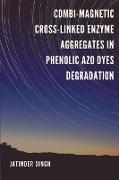- Start
- COMBI-MAGNETIC CROSS-LINKED ENZYME AGGREGATES IN PHENOLIC AZO DYES DEGRADATION
COMBI-MAGNETIC CROSS-LINKED ENZYME AGGREGATES IN PHENOLIC AZO DYES DEGRADATION
Angebote / Angebote:
Rapid industrialization and urbanization has led to the growth of various industries around the World. Among various industries, textile industries is one of the oldest and largest industries. As the demand of textile products is increasing, the wastewater generation is also increasing proportionately resulting in environment pollution, globally. Huge amount of water is utilized in the processes of textile industries, starting from washing, bleaching and dyeing of the fabrics. According to the World Bank, it has been estimated that 17 to 20 percent of industrial pollution in water comes from the dyeing textile industries. About 10-15% of the dyes used in textile industry enter into the wastewater stream. Dyes containing textile effluents causing serious environmental pollutions and health problems. Azo dyes is one of the largest group of synthetic dyes widely used in textile industry. They have mutagenic and carcinogenic potential. So, it necessitates its removal prior to its entry in to the environment. Biological treatment offers a cheaper and environment friendly alternative for colour removal in textile effluents. Enzymes secreted by microorganisms facilitate them to degrade dyes, due to their chemical and catalytic feature. The enzymes suffer from certain drawbacks such as storage instability, sensitivity to elevated pH and temperature, resulting in loss of activity and reuse and recovery problems. Enzyme immobilization could solve the obstacles associated with these problems. But the selection of a suitable carrier material is another big challenge in immobilization process. So, to overcome the selection of suitable carrier, a carrier free immobilization technique was involved i.e. cross-linked enzyme aggregates (CLEAs). However, the number of enzymes immobilized by CLEAs technology is limited. Chitosan coated iron magnetic nanoparticles can overcome the separation problem of CLEAs and improve the cross-linking efficiency of the enzyme with low Lys residue. The combi-magnetic cross-linked enzyme aggregates (CM-CLEAs) were prepared by using the chitosan coated iron magnetic nanoparticles (C-MNPs) as an additive into the crude enzyme solution followed by its precipitation process to form aggregates. This book is based on a study wherein azophloxine dye degradation was investigated using CM-CLEAs. The magnetic iron nanoparticles (MNPs) were prepared by co-precipitation of ferric chloride and ferrous sulphate salt. Further, chitosan coated MNPs were used to prepared CM-CLEAs (lac, LiP and MnP). The CM-CLEAs were assessed for the azophloxine dye degradation in simulated dye wastewater. The book concludes that CM-CLEAs are highly efficient for the degradation of azophloxine dye in simulated dye wastewater. The study can be extended to the pilot scale reactor level and dye decolourization and degradation efficiency of CMCLEAs can be assessed in real textile effluent.
Folgt in ca. 15 Arbeitstagen


